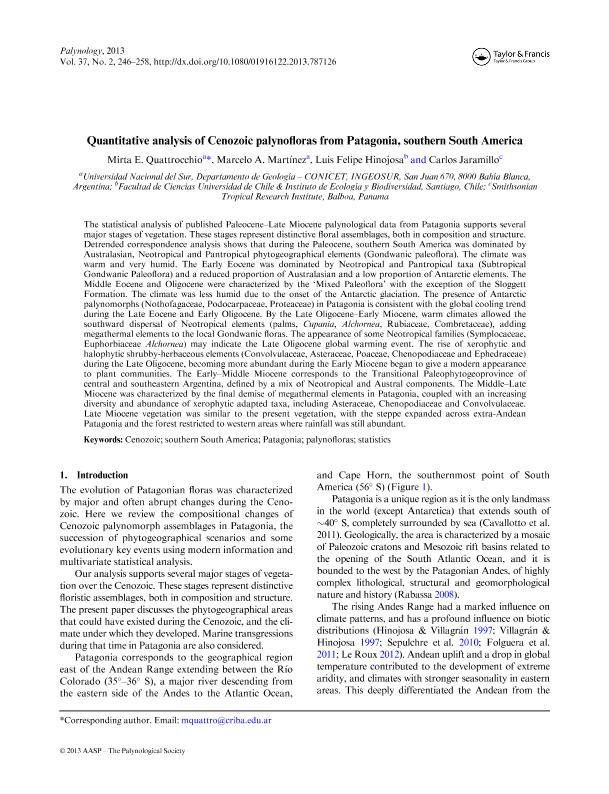Mostrar el registro sencillo del ítem
dc.contributor.author
Quattrocchio, Mirta Elena

dc.contributor.author
Martinez, Marcelo Adrian

dc.contributor.author
Hinojosa, Luis Felipe
dc.contributor.author
Jaramillo, Carlos
dc.date.available
2016-07-13T20:44:28Z
dc.date.issued
2013-01
dc.identifier.citation
Quattrocchio, Mirta Elena; Martinez, Marcelo Adrian; Hinojosa, Luis Felipe; Jaramillo, Carlos; Quantitative analysis of Cenozoic palynofloras from Patagonia (southern South America).; Taylor & Francis; Palynology; 37; 2; 1-2013; 246-258
dc.identifier.issn
0191-6122
dc.identifier.uri
http://hdl.handle.net/11336/6489
dc.description.abstract
The statistical analysis of published Paleocene-Late Miocene palynological data from Patagonia supports several major stages of vegetation. These stages represent distinctive floral assemblages, both in composition and structure. Detrended correspondence analysis shows that during the Paleocene, southern South America was dominated by Australasian, Neotropical and Pantropical phytogeographical elements (Gondwanic paleoflora). The climate was warm and very humid. The Early Eocene was dominated by Neotropical and Pantropical taxa (Subtropical Gondwanic Paleoflora) and a reduced proportion of Australasian and a low proportion of Antarctic elements. The Middle Eocene and Oligocene were characterized by the -Mixed Paleoflora-with the exception of the Sloggett Formation. The climate was less humid due to the onset of the Antarctic glaciation. The presence of Antarctic palynomorphs (Nothofagaceae, Podocarpaceae, Proteaceae) in Patagonia is consistent with the global cooling trend during the Late Eocene and Early Oligocene. By the Late Oligocene-Early Miocene, warm climates allowed the southward dispersal of Neotropical elements (palms, Cupania, Alchornea, Rubiaceae, Combretaceae), adding megathermal elements to the local Gondwanic floras. The appearance of some Neotropical families (Symplocaceae, Euphorbiaceae Alchornea) may indicate the Late Oligocene global warming event. The rise of xerophytic and halophytic shrubby-herbaceous elements (Convolvulaceae, Asteraceae, Poaceae, Chenopodiaceae and Ephedraceae) during the Late Oligocene, becoming more abundant during the Early Miocene began to give a modern appearance to plant communities. The Early-Middle Miocene corresponds to the Transitional Paleophytogeoprovince of central and southeastern Argentina, defined by a mix of Neotropical and Austral components. The Middle-Late Miocene was characterized by the final demise of megathermal elements in Patagonia, coupled with an increasing diversity and abundance of xerophytic adapted taxa, including Asteraceae, Chenopodiaceae and Convolvulaceae. Late Miocene vegetation was similar to the present vegetation, with the steppe expanded across extra-Andean Patagonia and the forest restricted to western areas where rainfall was still abundant.
dc.format
application/pdf
dc.language.iso
eng
dc.publisher
Taylor & Francis

dc.rights
info:eu-repo/semantics/openAccess
dc.rights.uri
https://creativecommons.org/licenses/by-nc-sa/2.5/ar/
dc.subject
Cenozoic
dc.subject
Southern South America
dc.subject
Patagonia
dc.subject
Palynofloras
dc.subject
Statistics
dc.subject.classification
Paleontología

dc.subject.classification
Ciencias de la Tierra y relacionadas con el Medio Ambiente

dc.subject.classification
CIENCIAS NATURALES Y EXACTAS

dc.title
Quantitative analysis of Cenozoic palynofloras from Patagonia (southern South America).
dc.type
info:eu-repo/semantics/article
dc.type
info:ar-repo/semantics/artículo
dc.type
info:eu-repo/semantics/publishedVersion
dc.date.updated
2016-07-12T15:20:14Z
dc.journal.volume
37
dc.journal.number
2
dc.journal.pagination
246-258
dc.journal.pais
Estados Unidos

dc.journal.ciudad
Nueva York
dc.description.fil
Fil: Quattrocchio, Mirta Elena. Consejo Nacional de Investigaciones Científicas y Técnicas. Centro Científico Tecnológico Bahía Blanca. Instituto Geológico del Sur; Argentina. Universidad Nacional del Sur; Argentina
dc.description.fil
Fil: Martinez, Marcelo Adrian. Consejo Nacional de Investigaciones Científicas y Técnicas. Centro Científico Tecnológico Bahía Blanca. Instituto Geológico del Sur; Argentina. Universidad Nacional del Sur; Argentina
dc.description.fil
Fil: Hinojosa, Luis Felipe. Universidad de Chile. Facultad de Ciencias; Chile
dc.description.fil
Fil: Jaramillo, Carlos. Smithsonian Tropical Research Institute; Panamá
dc.journal.title
Palynology

dc.relation.alternativeid
info:eu-repo/semantics/altIdentifier/doi/10.1080/01916122.2013.787126
dc.relation.alternativeid
info:eu-repo/semantics/altIdentifier/url/http://www.tandfonline.com/doi/abs/10.1080/01916122.2013.787126
dc.relation.alternativeid
info:eu-repo/semantics/altIdentifier/doi/http://dx.doi.org/10.1080/01916122.2013.787126
dc.relation.alternativeid
info:eu-repo/semantics/altIdentifier/url/http://palynology.geoscienceworld.org/content/37/2/246.full
Archivos asociados
